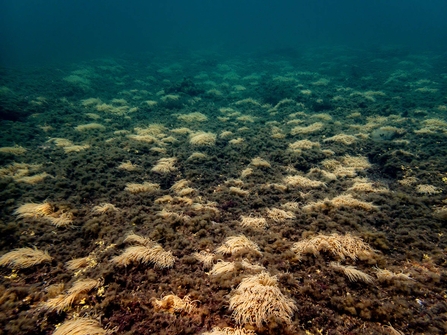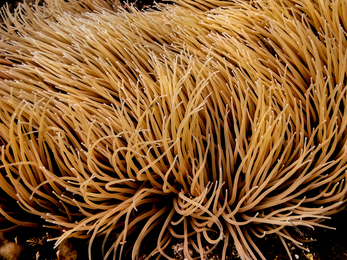While we have known about this remarkable underwater habitat for over 25 years, it is only relatively recently that we realised it might be unique. When we asked about similar habitat in other places, responses only mentioned small areas, a large seabed boulder or two at most. Coral weed and snakelocks anemones are commonly found together, it is the sheer size of our Kimmeridge bed that makes it stand out from the crowd.
Kimmeridge's Snakelocks Anemone Bed

Phil Abraham / Kimmeridge snakelocks bed
A snorkeller at the sea’s surface in clear, calm conditions can see a very defined edge to the bed which is surrounded by different types of seabed habitat including bushy seaweeds, broken boulders and sandy gullies. So about five years ago we decided to try and measure it, creating a team of volunteer snorkellers and setting dates for the attempt. Unfortunately, the weather was unkind and each time our survey date came around, so did the wind and rough seas! Following several failed attempts we finally managed to record the size this summer (2024), using GPS trackers, a snorkeller and a window kayak. When the track was marked onto an arial photo of the bay, the size of the bed was astounding.
Dorset Wildlife Trust / Snakelocks bed survey
Coral weed is a short, pink, calcareous seaweed often found in lower shore rockpools as well as shallow waters. Dotted amongst the coral weed are clusters of snakelocks anemones, a relative of jellyfish, with stinging tentacles held up to catch passing prey such as prawns and small fish. These sea anemones clone themselves by splitting in half, doubling each time from one individual to two, from two to four and so on. As a result, patches of these animals, all clones of an original individual, are formed, although the anemone can also reproduce sexually.
Snakelocks anemones vary in color, with straw-colored individuals, those with purple-tipped green tentacles, and some that fluoresce under UV light all found at Kimmeridge. In addition to being predators that catch prey with their stinging tentacles, snakelocks anemones host algae in their tissues, which provide energy through photosynthesis. The fluorescing individuals also contain GFP (green fluorescent protein), which makes them glow green under ultraviolet light and may help protect them from UV damage.
While a variety of mobile animals may occasionally stray into the bed, or live in rocky crevices within the area, the snakelocks anemone bed is dominated by these two species. In 2023 there was concern when the snakelocks anemone bed disappeared beneath a thick blanket of invasive “hook weed”, a non-native seaweed from the Pacific. Would our long-standing anemone bed survive beneath this blanket? Fortunately, by autumn the non-native seaweed had cleared, revealing the original “bed” beneath.
Sarah Hodgson / Bonnemaisonia hamifera
We have plans to carry out further surveys on this remarkable habitat. We would like to monitor its health going forwards as threats such as invasive non-native seaweeds, pollution and increased storminess and rising sea temperatures due to climate change, could all have an impact.
Learn more about conservation at sea in Dorset here.



